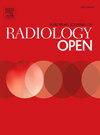基于深度学习的胸部HRCT三维内容图像检索系统:对间质性肺疾病和常见性间质性肺炎的性能评价
IF 2.9
Q3 RADIOLOGY, NUCLEAR MEDICINE & MEDICAL IMAGING
引用次数: 0
摘要
背景弥漫性肺实质疾病有多种症状和CT影像表现。鉴别间质性肺疾病(ild)和确定是否存在通常的间质性肺炎(UIP),可能是具有挑战性的,即使是经验丰富的放射科医生。为了解决这一挑战,我们开发了一个基于3d内容的图像检索系统(CBIR)并研究了其临床用途。方法利用深度学习技术,开发了一个原型系统,对全肺HRCT薄层图像进行分析,自动注册到数据库中,并检索相似图像。为了评估搜索性能,我们使用了一个包含2058个案例的数据库,并使用5分视觉评分来评估查询和检索案例之间的图像相似性(5分相似,4分有点相似,3分都不相似,2分有点不相似,1分不相似)。为了评估临床有用性,我们使用涵盖57种疾病的301例数据库,评估了查询和检索病例之间标签(ILD/非ILD,有/没有UIP)的一致性。结果在搜索性能方面,70个查询与前5个检索案例的视觉相似度平均得分为4.37 ± 0.83。对于临床有用性,在4个标签上评估25个查询和前5个检索病例之间的标签一致性。对于ILD,标签的平均一致性为0.94 ± 0.15,而对于非ILD,其平均一致性为0.64 ± 0.31。对于有UIP的病例,标签的平均一致性为0.86 ± 0.17,而对于没有UIP的病例,标签的平均一致性为0.83 ± 0.24。结论我们的CBIR系统对UIP有较高的识别准确率,可用于临床UIP的鉴别。本文章由计算机程序翻译,如有差异,请以英文原文为准。
Deep-learning-based 3D content-based image retrieval system on chest HRCT: Performance assessment for interstitial lung diseases and usual interstitial pneumonia
Background
Diffuse parenchymal lung diseases have various conditions and CT imaging findings. Differentiating interstitial lung diseases (ILDs) and determining the presence or absence of usual interstitial pneumonia (UIP), can be challenging, even for experienced radiologists. To address this challenge, we developed a 3D-content-based image retrieval system (CBIR) and investigated its clinical usefulness.
Methods
Using deep learning technology, we developed a prototype system that analyzes thin-slice whole lung HRCT images, automatically registers them in a database, and retrieves similar images. To evaluate search performance, we used a database of 2058 cases and assessed image similarity between query and retrieved cases using a 5-point visual score (5: Similar, 4: Somewhat similar, 3: Neither, 2: Somewhat dissimilar, 1: Dissimilar). To assess clinical usefulness, we evaluated the concordance of labels (ILD/non-ILD, with/without UIP) between query and retrieved cases, using a database of 301 cases across 57 diseases.
Results
For search performance, the mean score of visual similarity between 70 queries and their top 5 retrieved cases was 4.37 ± 0.83. For clinical usefulness, label concordance between 25 queries and their top 5 retrieved cases was assessed across 4 labels. For ILD, the mean concordance of labels was 0.94 ± 0.15, while for non-ILD, it was 0.64 ± 0.31. For cases with UIP, the mean concordance of labels was 0.86 ± 0.17, while for cases without UIP, it was 0.83 ± 0.24.
Conclusions
Our CBIR system showed high accuracy for identifying cases with/without UIP, suggesting its potential to support UIP differentiation in clinical practice.
求助全文
通过发布文献求助,成功后即可免费获取论文全文。
去求助
来源期刊

European Journal of Radiology Open
Medicine-Radiology, Nuclear Medicine and Imaging
CiteScore
4.10
自引率
5.00%
发文量
55
审稿时长
51 days
 求助内容:
求助内容: 应助结果提醒方式:
应助结果提醒方式:


